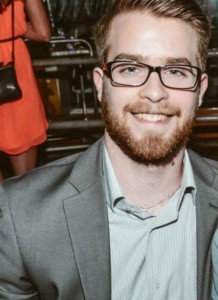Group 1 is composed of members April, Angela, Ashraf, Alexis, Nic and Sarah. Here is a short introduction by each member:
April: Hi! My name is April and I’m currently a third year student studying Food and Nutritional Sciences under the faculty of Land and Food Systems at UBC. I’m interested in research and development for the evolution of food and food systems, molecular gastronomy and food chemistry.

Angela: Hi, my name is Angela and I am a third year Food, Nutrition and Health student. Academically, I am interested in the relationships micronutrients share, both complementary and incompatible. I believe this has a huge impact in how we approach our diet in the future, as the full extent of how interconnected each aspect of human nutrition is becomes clear. Outside of school, I enjoy starting new hobbies and losing interest in them two weeks later, baking, eating, sleeping, and online retail therapy.
 Ashraf: Hi! My name is Ashraf, and I am studying Food Market Analysis here at UBC. I am keen about concepts such as nutrition, food policy development, trade systems and consumer behavior, all of which form the core of food market analysis. I am also interested in synergizing my background in science with knowledge in economics, finance and marketing, which is why I have taken on a minor in Commerce. Overall, the core of food science as well as the core of food resource economics and commerce will provide me with the knowledge on how to relate nutrition and health with the marketing of food, and complex consumption patterns, and hopefully take that knowledge back home to Uganda one day. Outside of school, I love watching TV shows, planning events as President of a club on campus, and eating of course!
Ashraf: Hi! My name is Ashraf, and I am studying Food Market Analysis here at UBC. I am keen about concepts such as nutrition, food policy development, trade systems and consumer behavior, all of which form the core of food market analysis. I am also interested in synergizing my background in science with knowledge in economics, finance and marketing, which is why I have taken on a minor in Commerce. Overall, the core of food science as well as the core of food resource economics and commerce will provide me with the knowledge on how to relate nutrition and health with the marketing of food, and complex consumption patterns, and hopefully take that knowledge back home to Uganda one day. Outside of school, I love watching TV shows, planning events as President of a club on campus, and eating of course!
Alexis: Hello, my name is Alexis and I am a 3rd year Food Market Analysis student at UBC. I grew up on a small, organic farm in Santa Cruz, California, and it was my experiences working both at home and with the community that inspired me to pursue a degree that focused on agricultural business. I believe a holistic approach to how we produce and consume foods is essential to creating a healthy and sustainable food system. I hope to enter and apply these concepts to the wine industry after finishing my education here. My passions outside of school include wine tasting, studying the art of mixology, hiking, and exploring the beautiful wilderness of British Columbia!

Nic: Hi my name is Nic. I’m a third year Food & Environment major here at UBC. Growing up in a farm town working on farms as a kid, I’ve always been interested in the way food gets from the farm to your plate. I am interested in the methods of food production used in our society and improving those methods to create a better and more efficient food system. Being a vegetarian, I have come to learn the importance of the farming systems and possible hurdles within them. Getting over these hurdles is what I find myself studying, and I love taking on these challenges.

Sarah: Hi there, my name is Sarah, and I am in my 3rd year as a GRS student and 5th year overall at UBC. My major involves choosing a region of the world, a language and a topic. I have chosen Europe, French and Sustainable Agriculture. My focus has shifted slightly over the years from the actual production of food to basically the entire food system, “from farm to fork”, as is so commonly said here on the west coast now. I spent the last school year on exchange in France and the Netherlands and learned a ton both inside and outside of school. I really looking forward to working on this community project, as I have a keen interest in learning about what types of farms and food production systems work well in our climate and market here in BC, with the goal of one day having my own operation.
As individuals, we each came from different upbringings and now with varied areas of study. Alexis and Nic grew up on farms, bringing their interest and first person knowledge of agriculture to the table. Nic, as a Food and Environment major, is studying the food system in detail, and thus can see areas needing improvement in Galiano’s Island food system efficiency. Alexis and Ashraf have educational backgrounds rooted in both economics and food, bringing another perspective to the discussion of community food security. On the other hand, April and Angela have educational backgrounds in food science and nutrition respectively, and thus are able to elaborate on community food security’s main tenets, food safety and accessibility to nutritious food. Sarah, as a Global Resource Systems student, can consider the unique geographical aspects of Galiano Island, and understand why certain crops are chosen by farmers. Together we form a diverse group of individuals who share in an interest to learn more about agricultural production, and its role in promoting community food security, as well as an eagerness to use the experiences we have gained from our lives leading up to the present for this cause.
Our goal with this project is to prepare an index of all agricultural products for sale on Galiano Island in collaboration with the Galiano Community Food Program, which will provide the inhabitants of Galiano Island with the resources necessary to plan for low-cost, healthy meals. The Galiano Community Food Program sees about 360 participants, which is a big proportion of Galiano Island’s population of about 1200 (Stats Canada, 2006). They are the leading organization of their kind, with their success encouraging neighbouring communities to follow in their footsteps. Their various programs and events aim to improve food security on Galiano Island, an objective that our group project intends to fulfill. To do this, we will be interviewing the inhabitants of Galiano Island, including farmers, shopkeepers, manufacturers of goods using local produce, and consumers.
Our process is especially relevant to Ernesto Sirolli’s TED Talk, which discussed several methods of how to help a community as an external group. It is essential to listen to their wants, needs, and concerns, rather than believing we know more about their land than the community does. This harbours a feeling of mutual respect for the knowledge and experience both the external group and the community have, resulting in a stronger working relationship, and a more effective outcome. Each community has many things to offer, some that are often overlooked, which is a problem that asset-based community development aims to abolish. Asset-based community development is rooted in using the strengths of each individual, and the inherent assets of each community. It fosters a closer relationship between citizens, as well as to the environment they call home. Ernesto Sirolli described a situation in which a needs-based approach had failed, when aid workers taught Zambians living in a fertile valley how to farm, an area previously lacking any form of agriculture. At the peak of their growth, the fruits of their labour were consumed by hippos, and this was the reason why the local peoples did not farm in such fertile land. If the aid workers had used an asset-based approach and asked the Zambians why they had no agriculture, they would have learned the reason why agriculture was not a feasible means to live for the Zambians.
The rapid deterioration of the resources brought by foreign aid workers in a needs-based approach is a main concern to the community in question. An example of this was given by Ernesto Sirolli (2012): Americans had given the African peoples 2 trillion dollars over the last 50 years, and this had done much more harm than good. According to Mathie and Cunningham (2003), sustainable development, brought by an asset-based approach, allows local citizens to become community leaders, rather than consumers of foreign aid. McCullum et al. (2005) outlines a three-stage model for improving community food security, a model that also uses an asset-based approach. The first stage consists of making sure the client has maximal access to all currently available resources, thus using the assets of the community. In this model, dietitians recommend their clients to purchase locally grown produce, which results in higher profits for local farmers and strengthens the local economy. In the second stage, McCullum et al. (2005) recommends putting new initiatives into place to establish the social infrastructure needed, and by moving “food distribution activities from private to public spaces.” Finally, in the third stage, self-reliance of the community to provide its members with healthy and sustainable food in the long-term is improved through enacting “public policies that integrate different policy fields” (McCullum et al., 2005). All three stages work together to establish long-term sustainability, benefiting not only the present, but that builds upon each of the community’s assets for a brighter future.
